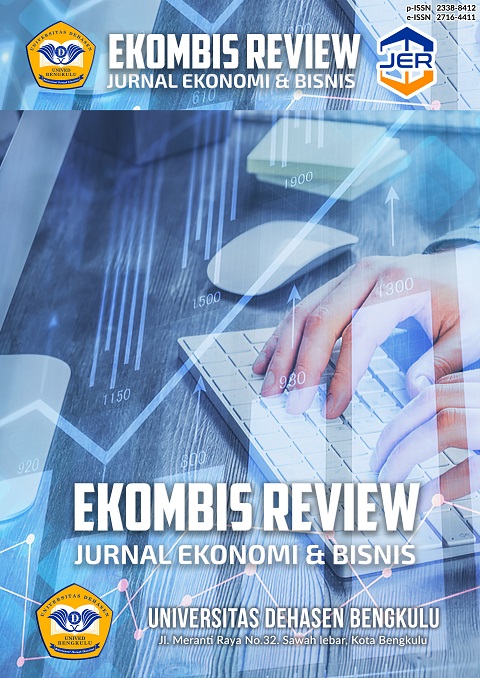Analisis Prinsip Nisbah dalam Pembiayaan Murabahah di Bank BSI KCP Lauser
Abstract
The phenomenon of murabahah financing is a contract based on buying and selling between the bank and the customer. Where the bank is the party that provides goods and sells them to customers by ordering goods to be purchased by customers. This study aims to examine and discuss the Indonesian Sharia Bank (BSI) KCP Lauser which estimates the profit earned so that it affects the ratio to be distributed. This study also discusses the ratio mechanism in murabahah financing at Bank Syariah Indonesia KCP Lauser. Then, discuss the implementation of the principles of profit-sharing ratio in murabahah financing by BSI KCP Lauser. The research method used is descriptive analysis method, which analyzes and presents facts about the implementation of the distribution of murabahah ratios carried out by Bank Syariah Indonesia KCP Lauser. This research was conducted to obtain primary sources of BSI KCP Lauser murabahah contract documents, murabahah financing tables and the results of interviews with the bank that performed the murabahah contract with the customer. The results of the study show that Bank Syariah Indonesia (BSI) KCP Lauser estimates the ratio to the bank's income, where the profit is based on the murabahah agreement agreed at the beginning of the agreement. Where the implementation is by buying and selling on murabahah, the bank will divide the margin. In general, the murabahah ratio at Bank Syariah Indonesia (BSI) KCP Lauser is appropriate because the provision of financing is based on a contract, the bank negotiates with the provider regarding the terms and conditions that will be used as the basis by the bank, the bank also makes an agreement with the customer. Then, BSI is also the executor of the offer, and on the date of delivery of assets the customer must submit a Murabahah Declaration, and the BANK will declare acceptance of the offer by signing the Murabahah Declaration and submitting it to the customer. Therefore, the ratio of Murabahah is very appropriate at BSI KCP Lauser. The murabahah financing mechanism at BSI KCP Lauser, the financing is not like conventional banks in general which lend money to customers. However, in this Islamic bank, according to customer needs.
Downloads
References
Barika, R. M. (2021). Pola Pembiayaan Syariah Murabahah Di Kota Bengkulu. The Journal Of Economic Development, 79-89.
Hariyanto, A., Asra, M., & Al-Hanun, W. (2018). Restrukturisasi Pembiayaan Murabahah Analisis Yuridis Peraturan Bank Indonesia. Lisan Al-Hal, 12(2), 329–346. https://journal.ibrahimy.ac.id/index.php/lisanalhal/article/view/158
Hasibuan, F. U., & Fakultas. (2019). Analisis Pengaruh Kewajiban Penyediaan Modal Minimum (KPMM), Beban Operasional Pendapatan Operasional (BOPO), Financing To Deposit Ratio (FDR), dan Inflasi Terhadap Return On Asset (ROA) Pada Bank Umum Syariah di Indonesia Periode 2016-2019. HUMAN FALAH: Jurnal Ekonomi Dan Bisnis Islam, 6(1), 19–36. https://doi.org/10.21043/malia.v4i1.6887
Irvan Muhamad Rizky, & Azib. (2021). Pengaruh Pembiayaan Mudharabah, Murabahah dan Musyarakah terhadap Return On Assets. Jurnal Riset Manajemen Dan Bisnis, 1(1), 16–24. https://doi.org/10.29313/jrmb.v1i1.35
Latif, C. A. (2020). Pembiayaan Mudharabah Dan Pembiayaan Musyarakah di Perbankan Syariah. Jurnal Ilmu Akuntansi Dan Bisnis Syariah, 9-22.
Muhammad Rizal Satria, T. S. (2018). Analisis Perbandingan Pemberian Kredit Pemilikan Rumah (Kpr) Pada Bank Konvensional dengan Pembiayaan Murabahah (Kpr) Pada Bank Syariah (Studi Kasus Pada Bank Bjb Dengan Bank Bjb Syariah). Jurnal Ekonomi Dan Keuangan Syariah Vol. 2 No. 1, 107-117.
Nasution, S. F. (2021). Pembiayaan Murabahah pada Perbankan Syariah di Indonesia. Jurnal Ekonomi Islam, Volume Vi No. 1 , 132 - 152.
Prabowo, B. A. (2009). Konsep Akad Murabahah Pada Perbankan Syariah (Analisa Kritis Terhadap Aplikasi Konsep Akad Murabahah Di Indonesia Dan Malaysia). Jurnal Hukum IUS QUIA IUSTUM, 1(16), 106–126. http://www.jurnal.uii.ac.id/index.php/IUSTUM/article/view/3835
Soendari, T. (2012). Metode Penelitian Deskriptif. Bandung, UPI. Stuss, Magdalena & Herdan, Agnieszka, 17.
Copyright (c) 2022 Isna Maulida, Tuti Anggraini

This work is licensed under a Creative Commons Attribution-ShareAlike 4.0 International License.
An author who publishes in the EKOMBIS REVIEW: Jurnal Ilmiah Ekonomi dan Bisnis agrees to the following terms:
Author retains the copyright and grants the journal the right of first publication of the work simultaneously licensed under the Creative Commons Attribution-ShareAlike 4.0 License that allows others to share the work with an acknowledgement of the work's authorship and initial publication in this journal
Submission of a manuscript implies that the submitted work has not been published before (except as part of a thesis or report, or abstract); that it is not under consideration for publication elsewhere; that its publication has been approved by all co-authors. If and when the manuscript is accepted for publication, the author(s) still hold the copyright and retain publishing rights without restrictions. For the new invention, authors are suggested to manage its patent before published. The license type is CC-BY-SA 4.0.
EKOMBIS REVIEW: Jurnal Ilmiah Ekonomi dan Bisnis is licensed under a Creative Commons Attribution-ShareAlike 4.0 International License.














